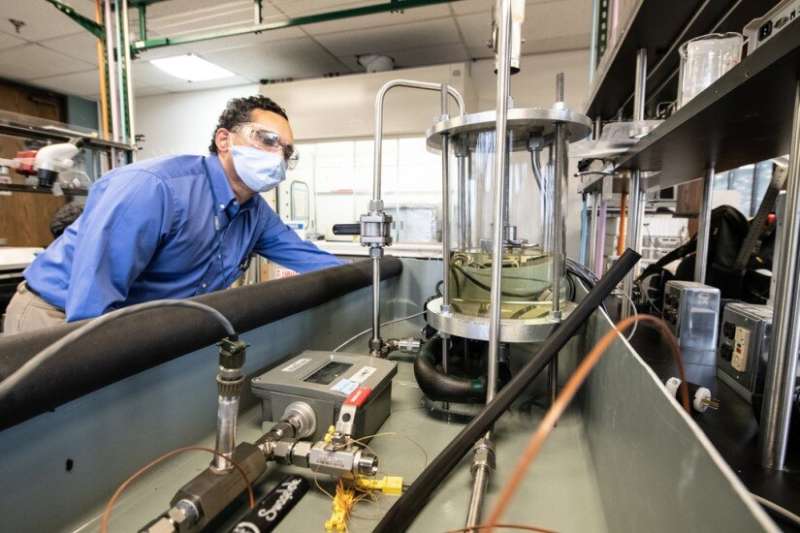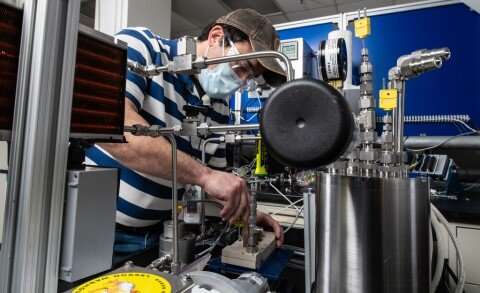Power electronics and electric machines system designs to revolutionize clean energy mobility

Always with an eye toward the future, National Renewable Energy Laboratory (NREL) researchers are revolutionizing clean energy mobility beyond light-duty electric vehicles (EVs) by building advanced power electronics systems that control the flow of electricity to propel large and advanced electric machines, including those used in planes, trains, and heavy-duty transportation. With support from the U.S. Department of Energy's Advanced Research Projects Agency-Energy (ARPA-E) programs, NREL is partnering on new research projects in sustainable aviation, grid storage, and energy-efficient computing.
"It's an exciting time to be working in power electronics," said NREL Senior Researcher Sreekant Narumanchi. "These important partnerships are enabling us to develop the most cutting-edge system designs to decrease costs, reduce component footprints, and improve overall performance, reliability, and efficiency."
Electrified mobility applications use power electronics, such as inverters, converters, and chargers, to manage electricity flow between the battery, electric motor, and other powertrain components. Depending on the application, systems must operate at higher temperatures, voltages, switching frequencies, and power conversion efficiencies. Advanced systems bring advanced challenges, but NREL researchers are pioneering new power electronics and electric motor packaging, semiconductor electro-thermal designs, and thermal management systems for transportation and manufacturing. NREL's experimentation facilities offer world-class evaluation and measurement in heat transfer, reliability characterization, package prototyping, and thermal and thermomechanical modeling.
State-of-the-art power electronics and electric machines for peak performance
Power electronics are at the heart of power conversion in an electric-drive vehicle, managing power flow between various components within the vehicle. Next-generation power electronics and electric machine designs can improve the performance of EV powertrain components and the digital technologies that make EVs safer and smarter. In larger applications, such as heavy-duty equipment, the power electronics also require high-power and high-temperature optimization.
As a leader in wide-bandgap (WBG) power electronics research, NREL evaluates and develops electro-thermal semiconductor designs and packaging technologies that offer improved reliability, power density, and efficiency. WBG devices, such as silicon carbide or gallium nitride, offer lighter, more compact, and potentially robust alternatives to traditional components. Continued research is helping highlight these advantages and increase the adoption of WBG systems.
"Our team is collaborating with industry partners, such as General Electric, Cummins, BorgWarner, and John Deere, to optimize the thermal performance of power-dense WBG inverters and electric motors," Narumanchi said. "The lighter overall weight, footprint, and improved performance of these designs offer clear benefits to fuel efficiency and operating costs for electrified mobility applications."
NREL researchers rely on leading-edge modeling and characterization to perform reliability evaluation and failure analysis of new power electronics designs. Advanced modeling capabilities allow researchers to identify thermal bottlenecks and optimize the performance of power electronics packaging. In addition, researchers leverage extensive characterization through thermal, humidity, and vibration testing to better understand how stressors affect emerging technologies. As a result, NREL-designed systems prioritize safety, reliability, and efficiency for peak operating performance.

Unparalleled thermal management and cooling capabilities
Overheating can cause irreparable damage to power electronics and electric motors, causing the system to slow down or malfunction. Advanced thermal management systems are critical to the performance and safety of all electrified traction drive components, including semiconductor power device, power modules, inverters, and electric motors. NREL engineers are experts in system-level thermal management designs that incorporate advanced heat transfer to regulate temperatures throughout the complete power electronics and electric machine system. In addition, recent innovative cooling strategies, such as jet impingement, push the boundaries of design for power electronics and electric machines.
"Advanced cooling and thermal management systems optimize performance of electric vehicles and advanced machines," Narumanchi said. "These systems help keep temperatures within operational limits, reduce the volume and weight of components, improve efficiency of components, and increase efficiency and range of the vehicle. Ultimately, these benefits contribute to reduced fuel consumption and greenhouse gas emissions."
An ongoing ARPA-E collaboration with Stanford University is "Exploring the Limits of Cooling for Extreme Heat Flux Applications," with improved chip thermal management for data centers and power electronics. Stanford University researchers are developing a novel cooling technology, the Extreme Heat Flux Micro- (EHFμ-) Cooler, supported by NREL's experimental reliability evaluation of the thermal management technologies. The EHFμ-Cooler significantly reduces device temperature, resulting in heat flux dissipation over 1,000 W/cm2 to cool the device.
NREL's thermal management research also includes two projects within the ARPA-E Aviation-class Synergistically Cooled Electric-motors with iNtegrated Drivers (ASCEND) program to support the development of innovative lightweight and ultra-efficient electric motors, motor drives, and thermal management systems for sustainable aviation. The first project, led by the General Electric Global Research Center, will design a 2-MW fully integrated all-electric aircraft powertrain and demonstrate a 350-kW lab-scale prototype to enable zero carbon emission narrow-body commercial aircraft with all-electric propulsion. The second project, led by Marquette University, focuses specifically on building a high-power-density motor for aerospace propulsion. NREL's support for these projects includes thermal management modeling, analysis, and characterization of the advanced cooling concepts and inverter components, alongside thermomechanical design and techno-economic analysis for various power electronics, electric motor, and integrated electric drive components.
Power electronics expertise for a clean energy future
These existing partnerships barely scratch the surface of NREL's advanced power electronics and electric machines capabilities, and more exciting research is just beginning. ARPA-E recently selected three new projects backed by NREL expertise:
- Repurposing Infrastructure for Gravity Storage Using Underground Potential Energy, led by NREL, will use electromechanical system-level modeling to determine drivetrain component sizing to convert inactive oil and gas wells into energy storage devices.
- Bringing Three-Dimensional Packaging and Thermal Management to Power Electronics, led by Synteris, will include NREL research to improve the thermal management, power density, performance, and lifetime of ceramic packaging for power electronic modules.
- Substation in a Cable for Adaptable, Low-Cost Electrical Distribution (SCALED), led by Virginia Polytechnic Institute and State University, will include NREL thermal management research to develop compact, high-performance power electronics components in the context of grid applications.
As part of the ARPA-E OPEN 2021 program, these projects prioritize high-impact, high-risk technologies that support novel approaches to clean energy challenges.
"Each of these projects involve exciting new collaborations with industry and university partners—as well as collaborations across groups at NREL—to develop pioneering power modules, packages, converters, and drivetrain components impacting multiple energy efficiency and renewable energy applications," Narumanchi said.


















